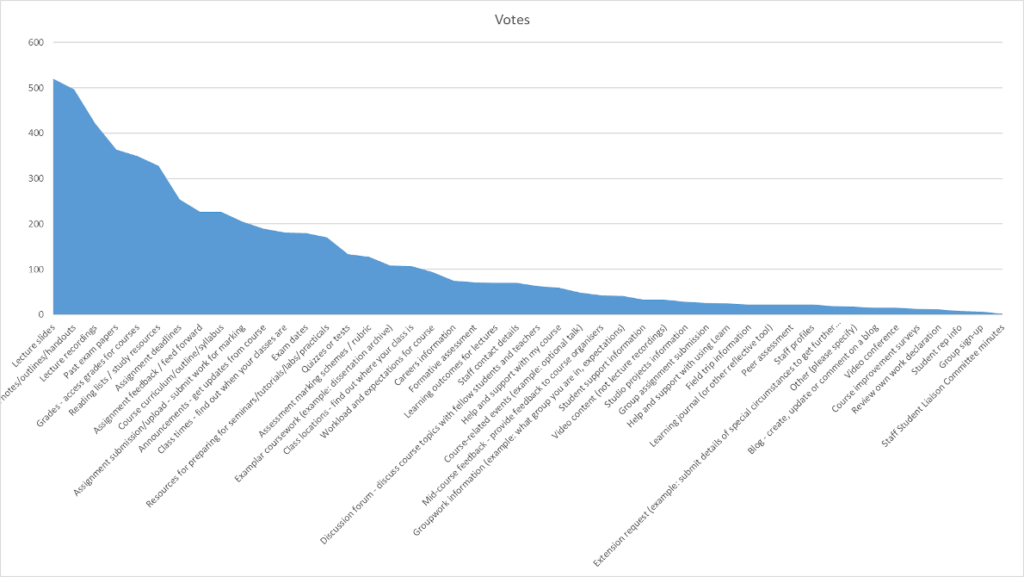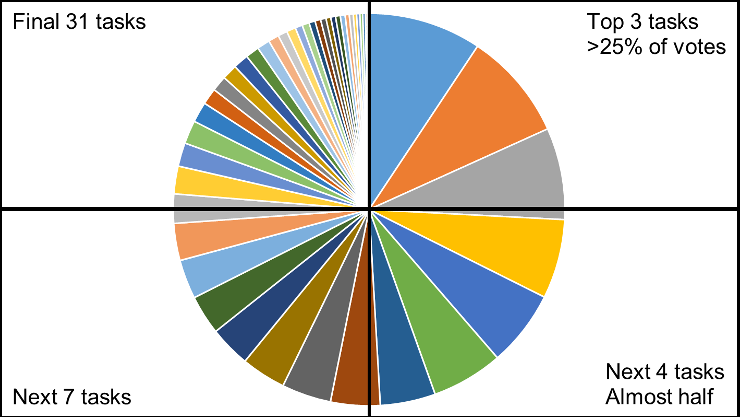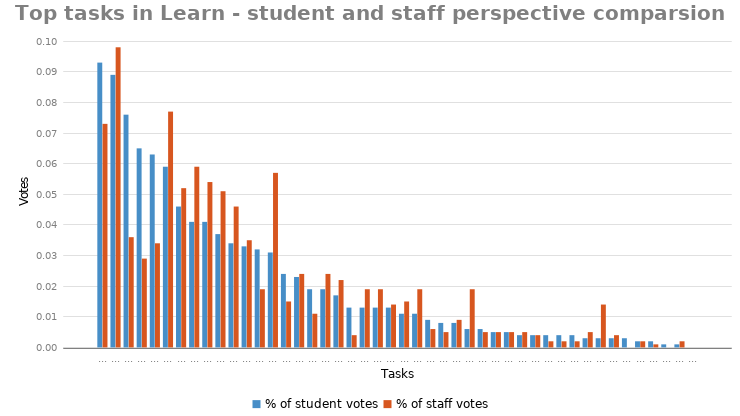Top tasks surveys have identified what really matters to students using Learn
As part of our programme of user research in support of the Learn Foundations project, we have carried out a top tasks survey to understand what students need when accessing course materials online.
Top tasks surveys are one of our go-to methods. It is a quick, easy, and powerful way to identify exactly what users need. The method has been pioneered by Gerry McGovern, whose top tasks masterclass I have written about previously:
Top tasks management – how to continuously measure your website’s success
It is often easy to get bogged down and overwhelmed by the number of possibilities available to us. This is particularly the case for a rich product like Learn, which offers a great deal of functionality. This can distract us from what really matters to our users.
The top tasks methodology enables us to identify those key items our users really care about.
Students’ top tasks when accessing course materials digitally
Because we wanted to capture students’ real needs, rather than just an understanding of how they use Learn, we asked them about accessing course materials digitally. That way, we limited the way respondents were influenced by what’s currently possible in Learn.
This survey asked students to select up to five important items out of a list of 46. 1,125 students completed the survey, with 5,565 votes cast.
Students care about lectures above all else
What we found was that students value three items much more than everything else. Those items are all to do with lectures.
- Lecture slides – 9.3% of all votes
- Lecture notes/outlines/handouts – 8.9%
- Lecture recordings – 7.6%
These three items took up over a quarter of all the votes. They are the only items to attract more than 400 votes.
These are hygiene factors. Students expect to be able to easily access these items as a minimum expectation. If it is difficult for students to find their lecture materials in a Learn course, they will be seriously frustrated.
Our interviews and usability tests with students have demonstrated that there are indeed cases where students struggle to find lecture slides and lecture recordings. In other words, if you only do one thing to improve your Learn environments, make sure it’s this.
Just seven tasks make up half of all students’ priorities
The next four top tasks take us up to almost 50% of all the votes.
These tasks are:
- Past exam papers – 6.5%
- Grades – access grades for courses – 6.3%
- Reading lists / study resources – 5.9%
- Assignment deadlines – 4.6%
In the top tasks methodology, this is known as “getting to know your long neck”. Every top tasks survey results in a zipf curve, or a “long neck and long tail” graph.

In the top left of the graph, these are the small handful of items that attract most of the votes in the study. The bottom right of the graph is the “long tail”. This is the set of what Gerry McGovern calls “tiny tasks” – the items that users don’t prioritise.
31 tiny tasks take up as many votes as the top three tasks

The pie chart shows the top 3 tasks taking up as many votes as the bottom 31
We presented students with 46 tasks to choose from. The bottom 31 tasks took up just a quarter of the votes – as many as those top three tasks about lecture materials.
The bottom item received just two votes out of the 5,565 cast.
Note that this doesn’t mean we shouldn’t include these items in a Learn course environment. But we should make sure that these items don’t distract us or our users.
A Learn course should be built around making it easy for students to complete the tasks that matter the most to them. This is fundamental to improving their experience when using Learn.
Staff members’ view of top tasks
We asked staff members to complete a similar study. We presented them with the same list of tasks as students. But we asked them to consider the top 5 things they thought students needed when accessing course materials digitally.
A similarly-shaped curve emerged. But there are some interesting differences in emphasis.

This bar chart demonstrates the differences in emphasis between staff and students
While students placed lecture recordings as their third top item, staff placed it only 10th.
Past exam papers is another one. While students placed it fourth, staff placed it 13th.
Meanwhile, staff viewed reading lists and study resources as being more important than students did, placing it second.
But even starker is the difference around resources for preparing for seminars/tutorials/labs/practicals. Students placed this 14th; staff placed it fifth.
Again, this is not necessarily to say that we should only prioritise students’ perceived needs. In fact, the purpose of running this study was to identify business requirements as well as user needs.
However, Learn Foundations is all about improving students’ digital experience. This data gives us some clues as to where there may be a gap between staff members’ perceptions, and what students say they really need. Many of our students’ top priorities are much lower down the list for staff.
Video
In this video I briefly introduce some of the key findings from these top tasks surveys.
See the data
If you’re a staff member, you can view some more of the top tasks data in more detail on the Learn Foundations wiki:
Learn Foundations user research wiki page
Find out more
This top tasks survey is just one strand of a programme of user research the User Experience Service has conducted as part of the Learn Foundations project.
- The elements of a better user experience in Learn – introducing our programme of quantitative research for Learn Foundations
- Other blog posts about the Learn Foundations project
- Further information about the Learn Foundations project
More posts to come will describe other strands of this user research in more detail.
Get in touch
If you’d like support in running a top tasks survey, visit the User Experience Service website and get in touch with us.


3 replies to “Top tasks surveys have identified what really matters to students using Learn”